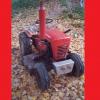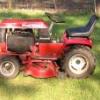
-
Similar Content
-
 By DennisThornton
By DennisThornton
1947 Empire (Jeep) Tractor
The Empire tractor consisted of military power components from World War II-era jeeps. It had a 4-cylinder, 40 hp Willys-Overland engine, a Model T-84 Spicer 3-speed transmission, Spicer transfer case with high and low speeds, Willys rear end, steering column and gearbox. It also had PTO, individual clutch-type rear brakes with a stop provided for parking and a rear belt pulley. The fuel tank and an Empire-style seat were mounted on a large operator's platform (made from Navy ship decking). Its simple, basic gauges (ammeter, oil pressure and temperature), ignition switch and starter button also came from the jeep. The Empire tractor was originally made for exportation in the Lend-Lease Program after World War II.
If I had to mention a couple of things that made the Empire Tractor really unique, one would be the straight bar hitch that pulled from under the center of the tractor (patented) thus making an overturn nearly impossible. The other selling point was, of course, the Willys engine and drive train made famous in the Jeep during World War II. The Empire was a well equipped tractor, very reliable and versatile with its wide range of speeds. Today this tractor draws a lot of attention at shows and is very sought after by collectors commanding higher than average prices.
$5k
-
 By CRE1992
By CRE1992
Well fellas I decided to buy a jeep wrangler as a new toy. I have always been into the off-roading scene since I was a kid. I always loved trucks, jeeps, atvs. Recently a friend of mine traded his mustang for a lifted wrangler and its a blast to go off-roading in or wheeling as they like to put it.
I couldn't help myself and wanted to join in so I bought a 1993 with 153,000 miles on it with a ton of add ons for a great price. It has a 5.5" suspension lift, a 2' body lift and rides on 35" tires. She has 4.56 gears which are awesome for crawling, 4wd low range and 1st gear and you don't even have to touch the gas pedal. It is a 4.0L 6 cylinder engine back by a 5 speed manual trans. The rear drive shaft is a custom cv drive shaft with a slip yoke eliminator. The rear axle is a ford 8.8 limited slip with disc brakes out of a ford explorer. The frame is perfect not a spec of rust and was coated with POR-15.
She does have her fair share of issues but I am working on getting those straightened out! I just had the front drive shaft rebuilt and balanced. I ordered all new extremely heavy duty shocks. I need to fabricate 2 custom rear shock mounts as the "custom" ones that were on it broke off lol. She needs 2 new leaf spring packs in the rear. Some body work. A good cleaning after this weekend. Some fender flares. Etc!
If anyone has any good oh crap off-roading or wheeling stories with their jeeps or pictures please share. After this past Sundays experience I could probably top them lol.
I hope you enjoy the pics and the video my jeep was the main attraction. (I did not edit the video a friend did, so turn down the volume or the music might scare you)
LINK FOR VIDEO: http://s1201.photobucket.com/user/silveradostud/media/Jeep%20Fun/IMG_31371_zps0e82da88.mp4.html
-
